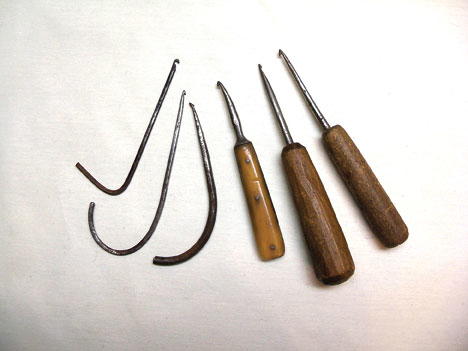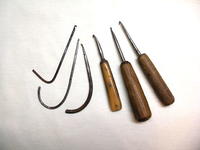Antique Rug Hooks

Hooked rugs are the most well documented of the traditional rugs, but with all the rug hooking books available, very little has been written about the hooks themselves. Rug hooks as we think of them really didn't come into use until the Arts and Crafts period in the 1890s. At that time, there was enough interest in rug hooking that needle manufacturers began to produce a standardized item called a rug hook. Typically, these hooks had wooden handles, a centered shaft with a hook, and a steel collar at the base of the handle. In earlier times, rug hooks were hand made individually, gradually evolving to the modern hook from a very different design and construction.
Eighteenth Century Rug Hooks
In the 1700s, blacksmiths made rug hooks just as they made all sorts of other household implements. Using a piece of small steel rod—either round or square—the hook was crafted at one end and the shaft bent at the other. These hooks did not have wooden handles. Instead, the hooker held the shaft to guide the tip and the curved end fit around the hand. These hooks did not require a tight grip since the force of the hand itself provided the pulling action for each loop.
The hooks shown here are three handmade rug hooks from the 18th century. Note that the hook ends are quite different as they likely came from different blacksmiths. Two are made of square rod and one of round rod. One hook shows signs of being shaped by a punch, while the others were cut into the rod. Many hooks of this age survive but often go unrecognized since they are so unlike modern rug hooks.
For being well over 200 years old, these old rug hooks still work and are surprisingly comfortable in the hand. Being steel, they show a lot of rust pitting, which is natural for their age, and all of them show signs of being well used.
This article is from the September/October 2011 issue. For more information on our issues, check out our issues page.



